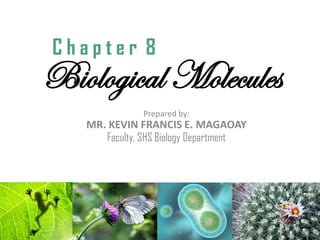
Lesson 8 Introduction to Biological Molecules
- 1. Biological Molecules Prepared by: MR. KEVIN FRANCIS E. MAGAOAY Faculty, SHS Biology Department C h a p t e r 8
- 2. Learning Objectives: Categorize the biological molecules according to their structure and function Explain the role of each biological molecule in specific metabolic processes
- 3. Overview: Definition of Biological Molecules Classification of Biological Molecules Structure and functions of Biological Molecules
- 4. Biological Molecules Biomolecules are essential molecules for all living organisms Have unique characteristics and properties that show how they contribute to the structure and function of the cells and how essential they are in maintaining life
- 5. Elements The simplest form of a substance found in the body such as C, H, O, N Compounds Made up of two or more elements that are chemically joined together Inorganic Compounds Water, Acid, Bases, Salt, Carbon Dioxide Organic Compounds Carbohydrates, Lipids, Proteins, Nucleic Acids
- 6. Element Simplest form of a substance Cannot be broken down into more simpler form 25 out of the natural elements are essential to life 98 – 99% of the body is composed of seven major elements namely C, H, O, N, P, Ca, S
- 7. Symbol Name Functions C Carbon Makes up 18% of the mass of the human body Main component of organic compounds H Hydrogen 10% of human body mass Essential in energy production O Oxygen 61-65% of total human body mass Used for cellular respiration
- 8. Symbol Name Functions N Nitrogen Makes up 3% of human body mass Key element of protein and nucleic acid P Phosphorus 1.2 – 1.5% of human body mass Important for bone structure Major component of nucleic acid S Sulfur 0.20 – 0.25% of human body mass Important components of proteins
- 9. Symbol Name Functions Ca Calcium 1.5% of human body mass Gives skeletal system its rigidity and strength Found in bones and teeth Important for muscle functions Si, Cl, Mg, Cu, Zn Minerals Other elements found in the body in little amounts Essential for growth and maintenance of the body
- 10. Symbol Name Functions Fe & I Trace Elements Elements that are indispensable to life but is required in minute amounts
- 11. Compounds A substance composed of two or more elements that are chemically bonded together Can be classified into inorganic or organic compounds Example: H2O, NaCl
- 12. Atomic Bonding Atomic Bond Description Covalent Bond Sharing of a pair of valence electrons by two atoms Represents sharing of electron Done to satisfy the octet rule Ionic Bond Attraction between oppositely charged atoms (CATIONS, ANIONS) Compounds formed from ionic bonds are called ionic compounds or salts
- 13. Atomic Bonding Atomic Bond Description Hydrogen Bonds Electronegativity The partial positive charge on hydrogen atoms that is bonded in an electronegative atom allows the hydrogen to be attracted to different electronegative atoms nearby Hydrogen bonds maybe intramolecular or intermolecular
- 14. Atomic Bonding Atomic Bond Description Van der Waals Forces Weaker than hydrogen bonds Occur over a very short distance When many of these interactions occur simultaneously, they can be powerful
- 15. Inorganic Compounds Also known as Inorganic Biological Molecules or Micromolecules These are compounds which are those without carbon
- 17. Water Versatile solvent Dissolves an enormous variety of solutes necessary for living Results from the polarity of its molecules When water is in liquid form, its hydrogen bonds are very weak. The hydrogen bonds form, break and reform with great frequency
- 18. Characteristics and Functions of Water Biological Solvent Ability to dissolve many substances including essential molecules in the body High Specific Heat Large amount of heat is needed to increase its temperature, thus it helps in maintaining the constant body temperature
- 19. Characteristics and Functions of Water High Heat of Vaporization Conversion of water from liquid to gaseous state which helps an organism in preventing dehydration High Heat of Fusion Helps an organism to maintain constant body temperature at low temperature Medium for Chemical and Physical Process Can serve as a place for gas and nutrient exchange and elimination of wastes Means of transport
- 20. Acids A substance that increases the hydrogen ion concentration of a solution When an acid dissolves in a solution, it donates hydrogen ions
- 21. Weak vs Strong Acids
- 22. Base A substance that decreases the hydrogen ion concentration of a solution When an acid dissolves in a solution, it accepts hydrogen ions
- 23. pH Scale
- 24. Property Acid Base pH Less than 7 Greater than 7 Litmus paper Blue to red Red to blue Taste Sour Bitter Odor Burning sensation Often no odor Texture Sticky Slippery Reactivity Reacts with metal to produce hydrogen gas Reacts with several fats and oils
- 25. Electrolytes or Salts Produced when an acid is combined with a base Conducts electricity within the body Na+OH- + H+Cl- Na+Cl- + H+OH-
- 26. Carbon Dioxide Essential for plants to perform photosynthesis Waste product from the breakdown of glucose
- 27. Organic Compounds Compounds containing carbon bonded to hydrogen (hydrocarbon) Carbon atom is the backbone of all macromolecules
- 28. How to Illustrate Organic Compounds? Molecular Formula
- 29. How to Illustrate Organic Compounds? Structural Formula
- 30. Macromolecule Macromolecules are large molecules necessary for life that are built from different combinations of smaller organic molecules Polymers built from monomers such as: CHO CHON CHONP CHONPS
- 31. Macromolecule Polymer A long molecule consisting of many similar or identical building blocks linked by covalent bonds. Monomer The repeating units that serves as a building blocks of a polymer
- 32. Monomer Monosaccharide - Monomer of Carbohydrates Amino Acids - Monomer of Proteins Nucleotides - Monomer of Nucleic Acids
- 33. Synthesis of Macromolecules Dehydration Synthesis Hydrolysis
- 34. Dehydration Synthesis Monomers combine with each other using covalent bond to form polymers
- 35. Hydrolysis Polymers are broken down into monomers
